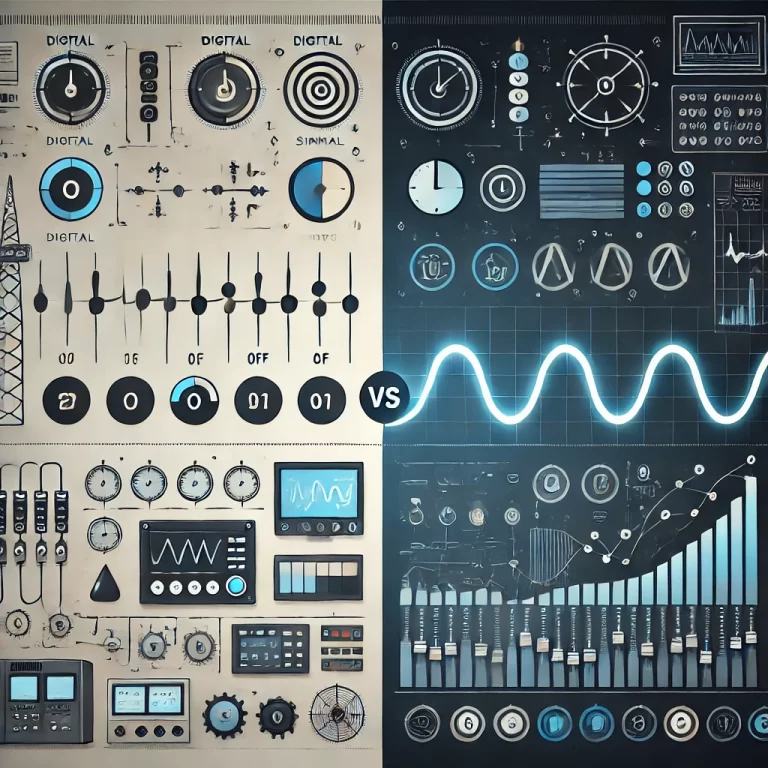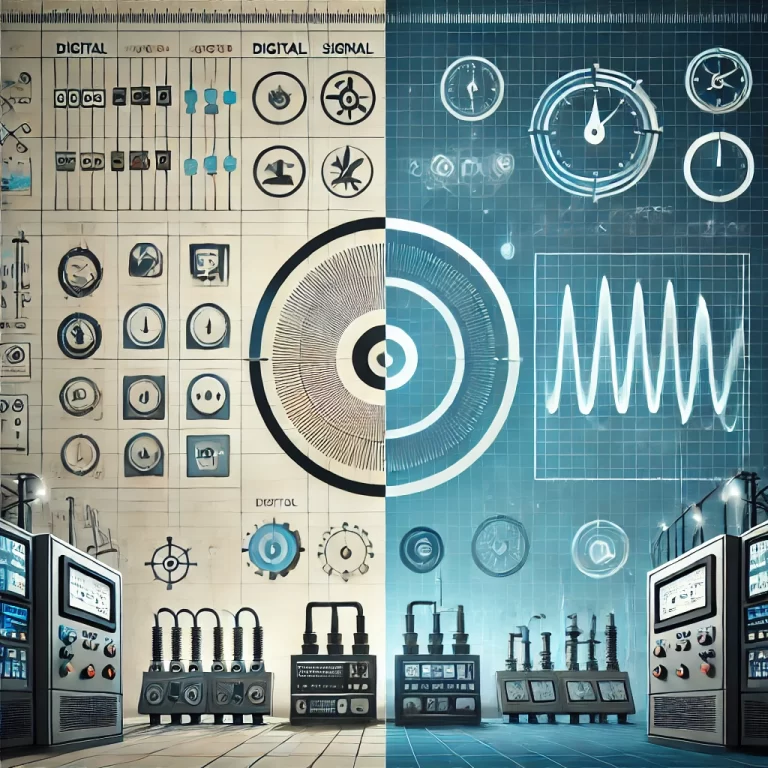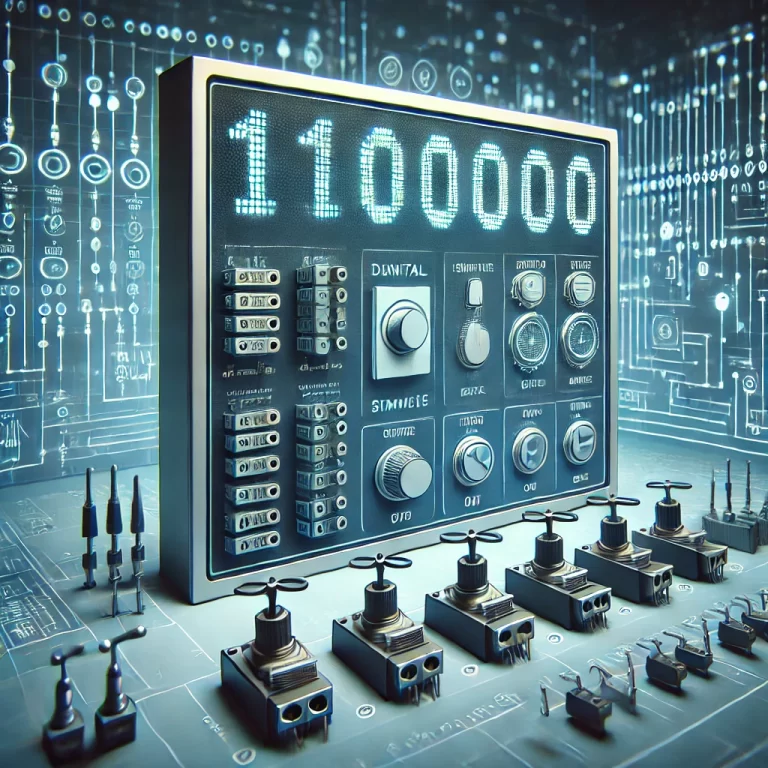Digital and analog signals are commonly encountered in industrial automation and control systems. They differ significantly in terms of signal characteristics, application scenarios, and processing methods. This article offers a detailed analysis of these two types of signals.
1. Basic Concepts
1.1 Digital Signal (Switching Signal)
A digital signal is a discrete signal that has only two possible states: ON or OFF. These states are typically represented as “1” and “0.” Digital signals are often used to represent the operation status of devices such as the start/stop of motors or the on/off state of switches. The main features of digital signals are that they are clearly defined, with instantaneous transitions between states.
1.2 Analog Signal
An analog signal, in contrast, is a continuous signal that can take any value within a specific range. It is commonly used to represent continuously changing physical quantities such as temperature, pressure, or flow rate. Analog signals provide a precise reflection of the measured change, as their values can vary continuously over time.
2. Signal Characteristics
2.1 Characteristics of Digital Signals
- Discreteness: Digital signals have only two distinct states, with no intermediate values.
- Instantaneous: The change between states is immediate, with no transitional period.
- Interference Resistance: Due to the binary nature of the signal, digital signals are less susceptible to interference and signal distortion during transmission.
- Simplicity: Processing digital signals is straightforward, often only requiring the detection of high or low voltage levels.
2.2 Characteristics of Analog Signals
- Continuity: Analog signals can take any value within a defined range, providing a continuous representation of the physical measurement.
- Transition: Analog signals change gradually, with intermediate values during the transition between different states.
- Interference Sensitivity: Analog signals are more susceptible to noise interference and can experience distortion during transmission, requiring additional measures to minimize this risk.
- Complexity: Processing analog signals is more complicated, often requiring Analog-to-Digital (A/D) and Digital-to-Analog (D/A) conversions, as well as signal conditioning like amplification or filtering.

3. Application Scenarios
3.1 Applications of Digital Signals
- Device Control: Digital signals are commonly used for controlling devices such as motors or valves, turning them ON or OFF.
- Status Detection: Used in applications such as limit switches or button status monitoring, where only two states are sufficient.
- Alarm Systems: Employed in systems such as fire alarms or equipment failure notifications, where a clear ON/OFF signal is required.
- Logical Control: In programmable logic controllers (PLCs), digital signals are often used for logic operations or conditional judgments.
3.2 Applications of Analog Signals
- Process Control: Analog signals are essential in regulating parameters such as temperature, pressure, and flow rate, where continuous adjustments are necessary.
- Environmental Monitoring: Used in systems that measure environmental factors like humidity, air quality, or light levels, where gradual changes are monitored.
- Precision Measurement: Analog signals are critical in applications like voltage, current, or frequency measurement, where precise, continuous data is needed.
- Automated Production Lines: Analog signals are also vital for adjusting material ratios, regulating speed, and managing other continuous processes in manufacturing.
4. Processing Methods
4.1 Processing of Digital Signals
- Input Processing: Digital signals are collected using digital input modules, which detect the ON or OFF states.
- Output Processing: Digital output modules control actuators such as relays or contactors based on the received digital signal.
- Logical Operations: In PLCs or controllers, digital signals are used to perform logical operations, enabling complex control functions.
- State Display: Digital signal states are often displayed through indicators like lights or screens, providing immediate feedback on the system’s status.
4.2 Processing of Analog Signals
- Input Processing: Analog signals are collected via analog input modules and are often subjected to Analog-to-Digital conversion (A/D) for digital processing.
- Output Processing: In systems requiring control, such as variable frequency drives or control valves, analog output modules are used to perform Digital-to-Analog conversion (D/A).
- Signal Conditioning: Analog signals often need to be filtered, amplified, or otherwise conditioned to ensure accuracy and reliability before further processing.
- Data Processing: Controllers may use sophisticated algorithms, such as PID control, for data processing, enabling dynamic adjustments based on continuously changing signals.

5. Advantages and Disadvantages
5.1 Advantages and Disadvantages of Digital Signals
Advantages:
- Simple Processing: Digital signal processing is straightforward, often requiring only state detection.
- Robustness: Digital signals are less prone to interference and distortion.
- Cost-Effective: Digital systems are generally less expensive to implement and maintain.
- Clear Logic Control: Due to the binary nature of digital signals, logical operations are easier to implement.
Disadvantages:
- Limited Information: Digital signals can only represent two distinct states, which limits their application in more complex systems.
- Not Suitable for Continuous Control: Digital signals are not ideal for controlling processes that require continuous adjustments, such as temperature or pressure.
5.2 Advantages and Disadvantages of Analog Signals
Advantages:
- Precise Representation: Analog signals can continuously reflect physical measurements, making them suitable for applications requiring high precision.
- Large Data Capacity: Analog signals can carry more information due to their continuous nature.
- Suitable for Complex Controls: Analog signals are well-suited for sophisticated control systems, such as those in process industries.
Disadvantages:
- Complex Processing: Processing analog signals is more complex, often requiring additional equipment like converters and conditioners.
- Interference: Analog signals are more susceptible to noise and interference, which can result in signal distortion.
- Higher Cost: The need for additional signal conditioning and conversion hardware makes analog systems more expensive.

6. Choosing Between Digital and Analog Signals in Practice
The choice between digital and analog signals depends largely on the specific requirements of the control system and the nature of the object being controlled.
6.1 When to Choose Digital Signals
- Simple Control Tasks: If the control task involves only two states (e.g., ON/OFF), digital signals are ideal.
- Low Complexity: If the controlled object does not require precise or continuous adjustments, digital signals are more suitable.
- Noisy Environments: In environments with significant interference or noise, digital signals are better because of their resistance to distortion.
6.2 When to Choose Analog Signals
- Complex Control Tasks: Analog signals are preferred when continuous control of varying parameters (such as pressure or temperature) is required.
- High Precision: If the controlled object needs real-time adjustments and frequent changes, analog signals provide the necessary resolution and smooth control.
- Stable Environments: Analog systems are more effective when the environment is relatively stable and free from significant interference.

7. Conclusion
Digital and analog signals each have their unique advantages and applications in industrial automation and control systems. Digital signals are suited for simple, binary tasks, offering easy processing and robust resistance to interference. On the other hand, analog signals excel in continuous, precise control scenarios, where changes occur gradually and require accurate representation. By understanding the characteristics, advantages, and ideal use cases of both types of signals, engineers can make informed decisions to select the most suitable option for a given task, ultimately optimizing the performance and reliability of control systems.
